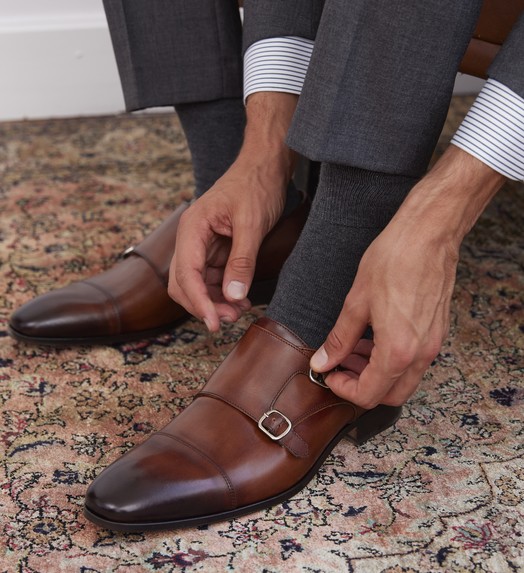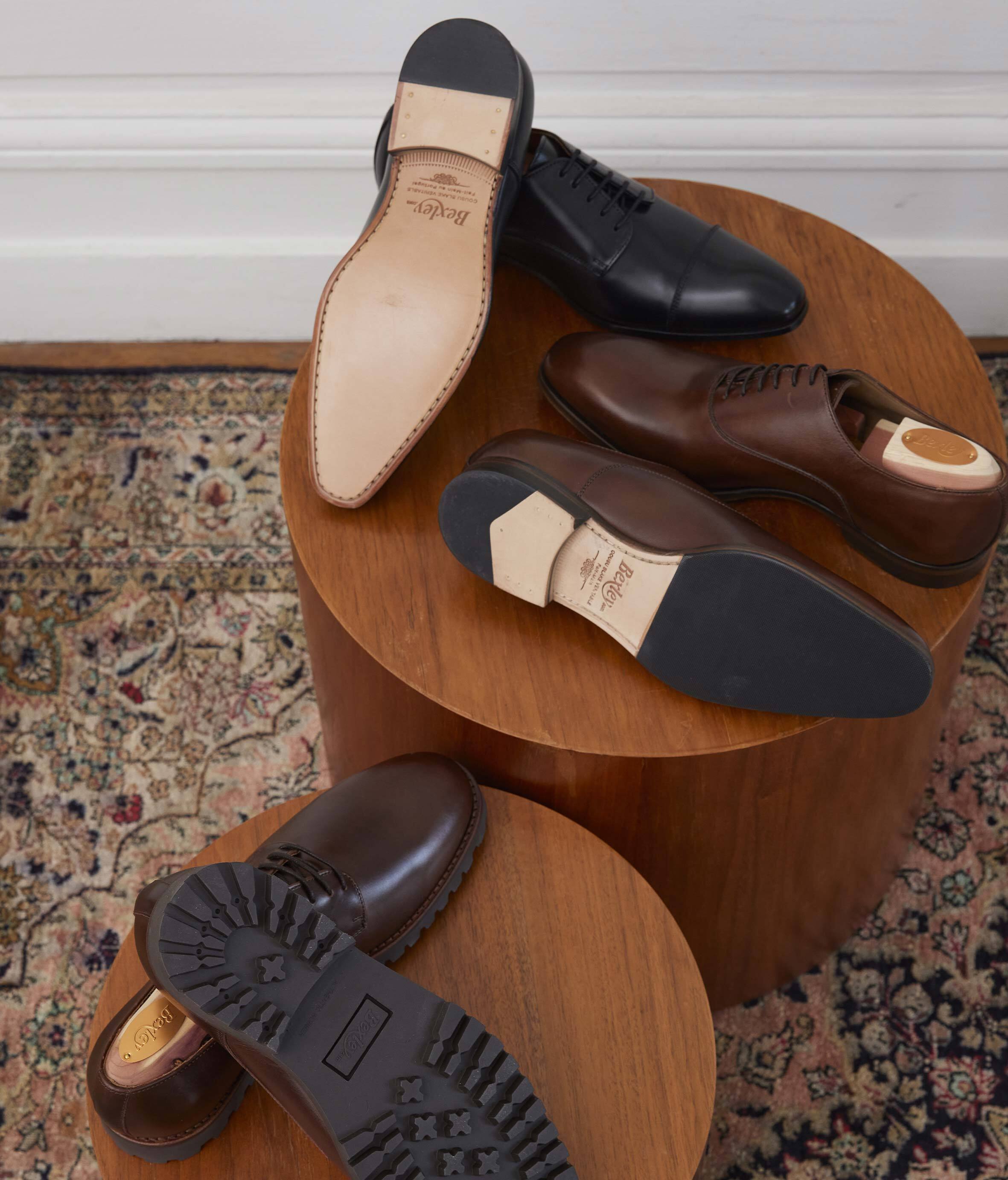- Home
- Guides & Tips
- Shoe guide
- Choosing dress shoes
Choosing a pair of dress shoes
If you’re thinking of going for one of the models of shoe that every man just has to have in his wardrobe, before you buy, make sure you’ve decided on selection criteria that go beyond just the style.
That’s because, if you choose a pair of dress shoes that doesn’t suit the shape of your foot or the way you’ll be using them, you may find you suffer from discomfort (or even pain) and that you reduce your shoes’ durability.
So Bexley has written a check-list of points to take into consideration so that you can find the right shoe for you!
The shape of your feet
If you’ve set your heart on getting a great pair of shoes, you mustn’t just look at the size (i.e. the length of your foot). Your feet are three dimensional and their shape might not suit every type of shoe. So you may have to accept that you just have to find an alternative model to the one you coveted so much.
First of all, the tips of your toes will decide which of 3 categories your feet belong to:

The Egyptian foot, where the big toe is the longest. This is the easiest shape to find shoes for, as most of the footwear you can buy is designed for this type of foot.

The Greek foot, characterised by having the second toe larger than the big toe. If this is you, you can wear round or pointed dress shoes, according to preference.

The Roman foot (aka square foot), where the first 3 or 4 toes are the same size. This is the hardest shape to fit, because you’ll have to avoid pointed shoes and go for ones where the toes are wide enough for comfort.
As well as the tip of your foot, your instep (the arched part in front of your ankle, between your leg and your foot) is another important feature to consider when choosing a shoe model.
Men with high insteps should opt for moccasins, boots, buckled shoes or Derby shoes: they will all be easier to put on and are roomier on the top of the foot than a pair of Oxfords.

In fact, trying on a pair of Oxford shoes can help you find out what sort of instep you have: if there is still an unattractive V shape between the two sides, despite having tried on a number of different sizes, then you have a high instep. This means you should avoid long, pointed dress shoes, as they may well hurt your feet.

Men with low insteps, on the other hand, should opt for longer models of shoe or pointed toes, as these will support their feet better. That’s because square-toed or very round-toed shoes will wrap around the feet as you walk along, making them feel uncomfortable.
Bexley recommends: Think carefully when choosing a new pair of shoes. It’s possible that the models you like best just aren’t right for the shape of your feet.
The right size
So, now you’ve taken the shape of your feet into account, you need to know how to choose the right shoe size.
Nothing could be easier than checking you have the right size shoes: try them on – on both feet! Believe it or not, many of us have one foot bigger than the other, so just trying one shoe on risks ending up with the wrong size.
Once the shoes are on your feet, they should feel well supported but not too tightly.
Remember that the leather is going to stretch a little widthways, but never lengthways, so if your longest toe is touching the end of the shoe, then the size is too small. There should always be a slight space between the tip of your toe and the end of the shoe.
If you notice a gap near the comfort crease at the end of the shoe, it means the shoe is too big and a smaller size would be preferable.
If, however, the next size down feels too tight, you could opt for a leather insole, so that foot and shoe meet more closely, delivering a better fit. Your feet are 3 dimensional, so it’s not always enough to just change the length.
Here at Bexley, we decided to offer our dress shoes in half sizes, to help you find the model that best suits your feet.

Bexley recommends: If you can, always try shoes on in the shop. If you order them on-line, make sure you look at the product sheet, where you will usually find advice about the fit. Otherwise, opt for your usual size.
Choose the right kind of shoe construction for their intended use
Do you wear dress shoes to the office several days a week, or just on the odd occasion? Depending on their intended use, it might be a good idea to choose a specific type of construction.
There are various methods assembling the different pieces of a dress shoe, two of which are called Blake stitch construction and Goodyear welt construction.
Neither is “better” than the other, as each has its advantages, and the one that might suit you best will depend on how you’ll be using the shoes and how comfortable they need to be.
Currently, shoemakers tend to use Blake stitching the most. It first appeared during the industrial revolution, as it involved stitching dress shoes on the inside, something that can only be done by a machine. This type of construction produced dress shoes with flexible, comfortable soles.
Goodyear construction - also known as the Goodyear welt, is a double stitched assembly with a more solid design than Blake stitching.
Renowned for its durability, it is described as being sturdy and waterproof, but you have to work at making shoes constructed with a Goodyear welt really comfortable! This type of construction is a good choice as long as you are prepared to live with a little initial discomfort, while you wait for the leather to stretch.
The Goodyear welt is so well-known that it gives the impression that this type of assembly is a better option, but that’s just hearsay: an excellent Blake construction is just as good as a Goodyear welt when it comes to a shoe’s robustness and durability.
Bexley recommends:a pair of shoes should never be worn more than one day running. You should let them breathe, by alternating at least every other day.
Every evening, when you take off your dress shoes, slip in a pair of shoe-trees, so that they don’t lose their shape.
If you buy a pair of shoes for a special occasion, remember to wear them in first, for one whole day at the very least, so that the leather can stretch and you can be comfortable on the big day.

A type of leather that combines comfort with elegance

Dress shoes come in different types of leather.
Comfortable, timeless and easy to look after, smooth leather is suitable for all sorts of times – work, week-ends and special occasions.
Smooth leather looks particularly good with formal outfits and suits. Yet smooth leather shoes will happily add a little touch of class to casual clothes too.
Oiled leather is leather that has been oiled. Its water-repellent properties make it particularly suited to walking or travelling in wet weather.
There isn’t really such a thing as suede leather. It’s actually a term used to describe nubuck or velvet leather. This type of leather is perfect for when you want to go for a more casual chic look. Nubuck/velvet leather (suede) can be worn all year round, because, despite what you might think, these materials are no more fragile than smooth leather. You just have to know how to look after them.
Bexley recommends:Remember to protect and care for your pair of leather shoes, with special products that will increase their durability
The type of outsole
Rubber, lugged or leather sole? Choosing the right outsoles for how you plan to use the shoes means they won’t wear out so quickly, so you’ll be able to wear them for longer. So you’ve really got nothing to lose by spending a little time on it.
For a pair of dress shoes that you’ll be wearing regularly, whether for work or to go out, go for shoes with a formal rubber sole. Choose this type of sole and you won’t regret it, summer and winter long.
A lugged rubber sole is the best choice in winter and on rainy days, as, just like tyres, they ensure a good grip whatever the terrain!
If you live somewhere that enjoys good weather, or, if not, on dry days, you can choose models with leather outsoles, as they are more elegant than rubber-soled models. You can wear them without non-slip pads if you like hearing the sound of leather when you walk, but watch out: slippery floors and leather soles do not make good bedfellows. To feel more secure, you could get soles with integrated non-slip pads, or have some added at the shoe repair shop.


 30 days
30 days 3D SECURE
3D SECURE